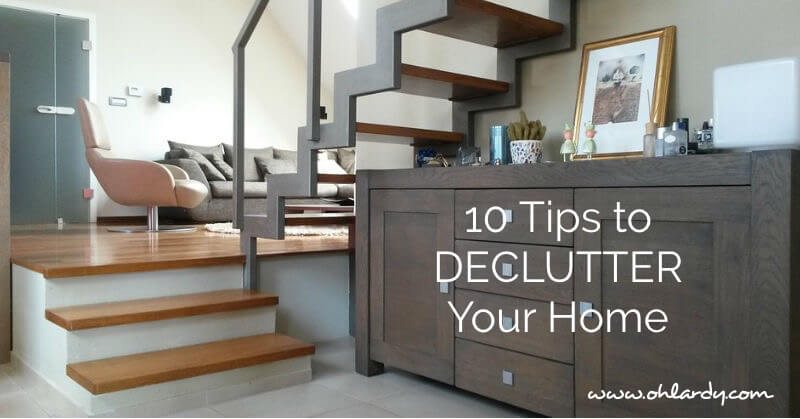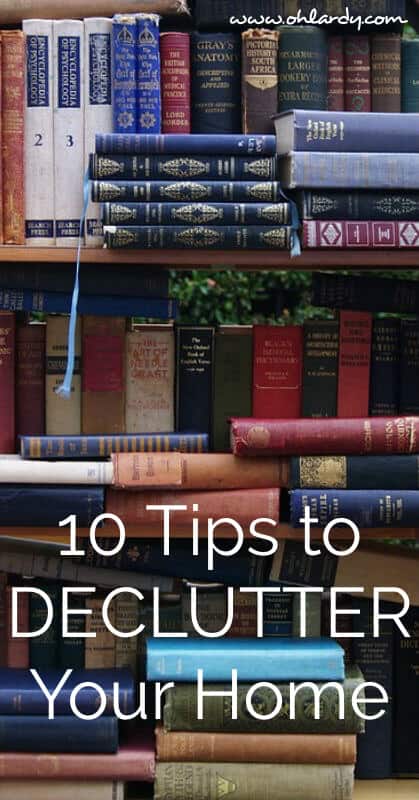10 Tips to Declutter Your Whole House
Oh Lardy! is a participant in the Amazon Services LLC Associates Program, an affiliate advertising program designed to provide a means for us to earn fees by linking to Amazon.com and affiliated sites.

by Elizabeth Greene
The goal of decluttering is fairly straightforward; if you want to make room in your home for the things that matter, you have to get rid of the stuff that doesn’t. With the holidays just around the corner, you’ll be needing extra space for friends and family, gifts (those you’re giving and those you receive), and of course, some cheerful decorations.
So, how do exactly does one go about decluttering an entire house? As someone who’s done it far too many times, I’m happy to share the tips that made the process easier for me — and hopefully will for you too!
Divide & Conquer
Hands down, the the most beneficial advice I’ve ever received when it comes to decluttering came from a Cork’d article:
The best approach is to attack one room per work period. That way, you'll have a clear stopping point or, at the very least, an understanding of when to take a break.
While you might be tempted to move from one space to another, it's simply not efficient. Instead, focus on one room and finish it before starting on another. Start by dividing the room into sections. Go through each section one at a time, and take a small break as you finish.
If you’re anything like me, you want to start a project and finish it on the same day. Unfortunately, decluttering a house simply doesn’t work that way. If you try to do it all at once, you’re likely to become frustrated and eventually burn out. In order to stay motivated, do one room per day. This will give you plenty of time to sort through items, make decisions on what to keep, and clean surfaces as you go.
Sort
A sorting system is one of the most important components of a decluttering project. Feel free to create your own method, or use the “the four-box method.” This method consists of sorting items into four categories: trash, give away, keep, or relocate. As you move through the room, make a decision item by item, and place it into one of the four boxes. Don’t pass over anything — every item in the room needs to be sorted.
Making the Decision
It’s not always easy to decide what stays and what goes, but it has to be done. Here are three things to ask yourself when examining an item:
- Does it work? If it’s broken, get rid of it.
- When did I last use this? If you haven’t used it in the last six months, get rid of it.
- Do I love this? If the answer is no, get rid of it.
For items in good condition, toss them into the donate box. Broken objects can be trashed — or, if you’re feeling particularly giving, you can repair them and then donate.
Keep Like Things Together
You’ll want to categorize like items as you go through each room, and then place them together in an area close to where you’ll use them — e.g. writing utensils in the office, safety and clothespins in the laundry room, utility cords in the garage, etc. It will make your life so much easier because you’ll always know where things are when you need them.
Clear Flat Surfaces
Counter tops, shelves, tables, desks, and other flat surfaces gather clutter like no other. Clear the flat surfaces in your home and ask yourself if that’s really the best place for the items that occupied them. It’s okay to keep a few essential objects (lamps, decor, frequently used small appliances, etc.) on your flat surfaces, but make it a goal to eliminate most clutter.
Clean Out Drawers
Drawers are another magnet for clutter. Empty each drawer you come upon and ask yourself the following questions:
- Does this item belong in this room?
- Have I used this in the last year?
If you answered “no” to either of those questions, place the object in the relocate, donate, or trash bin. When it’s time to place items back into the drawers, add dividers or containers so you can easily store like things together.
Empty Closets
At some point in our lives, we’ve all “cleaned” a room by shoving everything into the closet. It’s no wonder closets are clutter magnets! Depending on the size of a closet — or how cluttered it is — you may want to make it a separate project from the room it resides in.
Start from the bottom and work your way up in order to free up space in which to move. Remove everything from the shelves and wipe them down. For clothing and shoes, get rid of anything that doesn’t fit, is stained or torn, or hasn’t been worn in over a year. If it’s a seasonal item (or sentimental), free up some space in your closet by storing it.Get rid of any items that don’t add value to your life, and store the rest in boxes and bins on the closet shelves. Don’t stack things! Instead, add more shelving.
Categorize Paper Items
I’m not sure why, but nothing irritates me more than paper clutter. It doesn’t matter if it’s a bill, warranty, tax document, or a receipt — if it’s not where it’s supposed to be, I automatically want to trash it. Of course, that often leads to more trouble than it’s worth. That’s why keeping your paper items properly filed is so important. Here are a few tips for doing so:
- Sort any papers you come upon during the course of your cleaning into three piles:
- File
- To-do
- Trash
- Once you have everything sorted, shred the trash pile, file the papers you need to keep, and set aside your to-do pile so you can address it later. Don’t know what to keep and what to get rid of? Check out this handy article.
- If you have important documents that don’t require a physical copy, scan them to make a digital record, then shred the papers.
- Older files, (taxes, medical document, etc.) can be stored in a waterproof container and kept in a space for things you don’t need access to often.
Once you’ve finished, designate a space for incoming paper documents. This way, you’ll have a place to put them and you’ll keep paper clutter from rearing its ugly head in the future.
Catalogue Photos & Keepsakes
Take a moment to ponder this: if you had to flee your home due to a fire or natural disaster, could you find your most cherished possessions within seconds? If the answer is no, it might be time to consolidate!
Sort your keepsakes into things you wish to keep and things that can be thrown away. Now, I’m well aware of just how hard it is to trash keepsakes, but there are certain things that can go. For instance, you can get rid of:
- Other people's memories — favors from your friends’ weddings, programs from family members’ graduations, etc. You’re not responsible for holding on to other people's’ memories.
- Negative mementos — Keepsakes should make you feel nostalgic, so for goodness’ sake, don’t keep things that make you feel bad when you look at them! Photos of exes, angst filled diaries, notes from friends who dumped you — toss them out and let that baggage go!
- Surplus keepsakes — You don’t need to keep all the extra programs or invitations from those special events in your life. Instead, pick the best representative and trash the rest.
Once you have only the keepsakes you plan on saving, choose a container to store them in. You’ll want this container to be durable (to protect its contents), as well as portable, should you need to grab it and run. For mementos that either don’t fit in the box, or you’d prefer to display, use your crafting skills to create a memory album or shadow box.
Then of course, we have the photos. I have yet to meet a person that doesn’t have a giant box of photos that needs to be organized. If you’re ready for the challenge, start by getting rid of doubles, and photos that are badly damaged or out of focus.
Next, scan the photos so you have digital copies (see some tips on how to do that here.) This will keep them safe, preserve them for years to come, and make it easier to print copies for friends and family. Finally, sort the photos into albums and share the memories with your loved ones.
Add Storage
Wait, in an article about getting rid of items, there’s a section for adding things? Of course! Organizing your house is always far easier when you have proper places to store things. Adding storage should always be the last step in decluttering your house. It’s only once you know what you have, where it needs to go, and how much space it requires, that you can you get the proper storage container.
Here are a few items you might consider:
- Small containers or dividers that fit in drawers.
- Closet storage systems.
- Baskets to hold frequently used items.
- Shelving for any objects that are usually stored out in the open.
- Furniture/storage combos to store items you’d prefer to conceal.
- Durable Baskets to store infrequently used items in the attic, basement, shed, or garage.
Once you have things neatly filed away, you might want to consider adding labels to the containers so you don’t have to rifle through everything just to find the item you’re looking for.
Decluttering the house is a huge project, so remember to be patient, give yourself plenty of time to finish, and take lots of breaks. You got this!


Great article!
My decluttering tip is to buy a buy a large notebook and divide your page into two columns – “Essential” and “Non-Essential”.
Then go around the room, put every single item in one column or another.
When you have finished your “hit-list”, move the offending items to a designated collection point.
Thank you for sharing these awesome points. Will definitely try them. Cheers! 🙂
Can’t wait for some decluttering for this weekend! awesome post and thanks for sharing.
WOW! lovely like this post. What a great review. it’s really amazing.